Preferences- prefer would prefer rather than had better would like
Download as ppt, pdf6 likes3,980 views
www.yolyordam.com
1 of 23
Downloaded 501 times




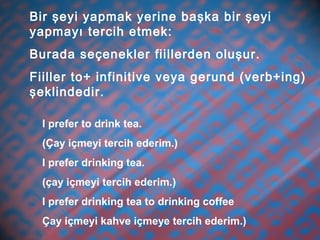
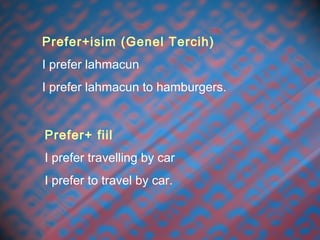
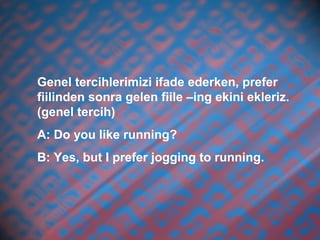
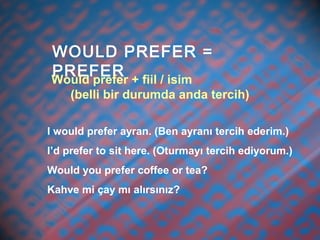


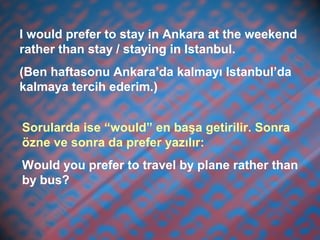
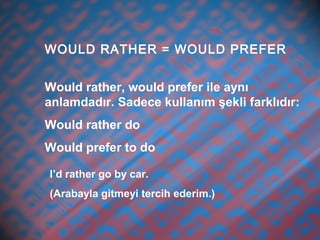
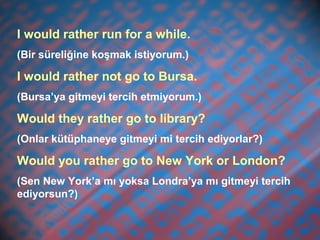




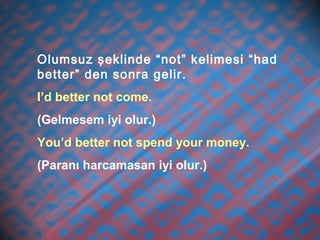

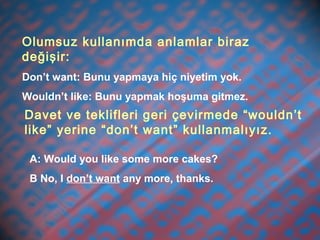
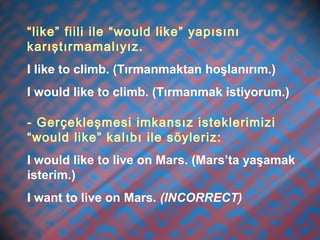
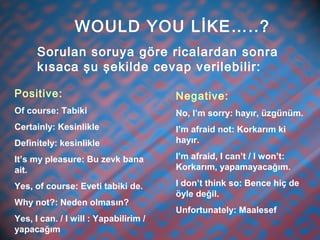

Ad
Recommended
Preposição de tempo: IN, ON e ATWay2Master
╠²
Este documento ensina sobre o uso das preposi├º├Áes de tempo IN, ON e AT em ingl├¬s. Explica que usamos IN para per├¡odos de tempo como anos, esta├º├Áes e hor├írios do dia. ON ├® usado para datas espec├¡ficas, dias da semana e express├Áes como "on time". AT ├® usado para hor├írios espec├¡ficos e express├Áes como "at night", "at present" e "at the moment".Prepositions of PlaceRenan Meira
╠²
Este documento explica as principais preposi├º├Áes de lugar em ingl├¬s: IN, AT, ON, NEXT TO, UNDER, BEHIND, BETWEEN, AMONG e fornece exemplos de como cada uma ├® usada para indicar a localiza├º├úo de objetos ou pessoas.How much and how many
How much and how manyCarmen Bazurto
╠²
This document provides a lesson on using countable and uncountable nouns correctly with quantifiers like "many" and "much". It explains that countable nouns can be counted and take quantifiers like "a/an" and "How many", while uncountable nouns cannot be counted and take quantifiers like "some" and "How much". Examples are given of countable foods like oranges and potatoes versus uncountable foods like rice and sugar. Readers are asked to identify countable foods in a list and complete sentences using "many" or "much" correctly based on whether the subject is countable or plural.Superlative adjectivesgepoteriko
╠²
O documento lista as formas comparativas e superlativas de v├írios adjetivos em ingl├¬s. Ele explica que os adjetivos de uma s├¡laba formam o superlativo com -est, enquanto os de mais de uma s├¡laba usam most + adjetivo. Tamb├®m fornece exemplos irregulares como good, bad e far.Aula de Ingl├¬s - Comparative and Superlative pridamico
╠²
O documento explica as formas de comparar e usar graus de compara├º├úo em adjetivos e adv├®rbios em ingl├¬s. Detalha as regras para forma├º├úo do comparativo e superlativo de igualdade, inferioridade e superioridade dependendo do n├║mero de s├¡labas do adjetivo ou se o adv├®rbio termina em "ly". Apresenta tamb├®m exce├º├Áes irregulares.Present Progressive Presentation
Present Progressive Presentationyarelli herrera
╠²
The document discusses the present progressive tense in English. The present progressive is used to emphasize actions that are ongoing or happening at the moment of speaking. Examples are provided of its use in affirmative, negative, and question forms with various subjects. Exercises are then provided to practice forming sentences using the present progressive tense, including exceptions in spelling and questions using interrogative words.Getting to know you! First English Class
Getting to know you! First English ClassMaurício Coelho
╠²
This document provides information about an English class, including:
- Documents required are a high school certificate and identification documents.
- Class times are from 9:30 to 12:10. Only 4 justified absences are allowed.
- There will be 2 tests - an oral and writing test, with make-up tests available.
- A book must be kept with extra activities and a logbook.Past Perfectssuser67d912
╠²
O documento explica o uso do tempo verbal past perfect, que expressa a├º├Áes que ocorreram antes de outras no passado. Ele aborda a forma├º├úo desse tempo verbal, suas formas negativa e interrogativa, e destaca a diferen├ºa entre verbos regulares e irregulares. Al├®m disso, inclui exerc├¡cios pr├íticos para refor├ºar o aprendizado.Modal CanNarielyn Elias
╠²
O modal can ├® usado para expressar habilidade, permiss├úo ou possibilidade. Ele pode ser usado para perguntar sobre habilidades de algu├®m ou para afirmar o que algu├®m ├® capaz de fazer. O can tamb├®m ├® usado para oferecer ajuda ou sugerir a├º├Áes.OBJECT PRONOUNS.pptxSilene Silva
╠²
O documento explica os pronomes em inglês. Define pronomes como palavras que substituem substantivos. Discute pronomes objetivos e pessoais, e quando usar "eu", "você", "ele/ela", "isso", "eles" e "nós". Fornece exemplos para ilustrar o uso correto de cada pronome.Subject Pronouns & Verb to beNarielyn Elias
╠²
O documento explica os pronomes pessoais em ingl├¬s e o verbo "to be". Apresenta os pronomes de primeira, segunda e terceira pessoa no singular e plural e destaca suas fun├º├Áes. Tamb├®m explica as formas afirmativa, negativa e interrogativa do verbo "to be".Object pronouns
Object pronounsLjubica Ruzinska
╠²
This document provides examples and explanations around the use of object pronouns in the English language. It defines object pronouns as pronouns that substitute nouns and always follow verbs. The document then lists the subject and object pronouns, provides 7 examples of sentences using object pronouns, and a practice section where readers change nouns to the corresponding object pronouns.Unit 9 N.I. 1
Unit 9 N.I. 1Jose Maria Jaramillo Salazar
╠²
The document provides vocabulary and examples for describing people's physical appearance, including their hair, age, height, and general appearance. It gives sample sentences for describing what males and females look like and templates for filling in details about hair color, eye color, height, and other physical traits. Examples are given for describing famous Mexican band members and for writing a self-description.Lesson 20 countable and uncountable nouns
Lesson 20 countable and uncountable nounsOyunErdeneErdenebile1
╠²
1. The document discusses countable and uncountable nouns. Countable nouns can be counted in units (e.g. one apple, two apples) while uncountable nouns cannot be counted in units (e.g. butter, coffee, meat).
2. Both countable and uncountable nouns can be measured using measuring units like cups, spoons, bottles which express an exact amount, or quantifiers like some, many, a lot which express an inexact amount.
3. The difference between how many and how much is that how many is used to ask about plural countable nouns while how much is used to ask about uncountable nouns. Examples7 ano Preposição.pptxKtiaOliveira68
╠²
A preposi├º├úo ├® uma palavra que liga um substantivo ou pronome a outro termo da ora├º├úo, indicando a rela├º├úo entre eles. Ela indica circunst├óncias como tempo, lugar, meio e modo. Exemplos de preposi├º├Áes em portugu├¬s s├úo "em", "de", "para", "com" e "sobre".Las comidas y alimentosLitelm├íria Sampaio
╠²
El documento lista diferentes tipos de frutas, verduras, l├ícteos, carnes, granos, dulces y comidas r├ípidas que son parte de una dieta balanceada. Incluye frutas como la naranja, sand├¡a, pl├ítano, fresa y guayaba, verduras como el berro, br├®col y espinaca, l├ícteos como la leche, queso y yogur, carnes como el pollo y pescado, granos como el arroz y ensalada, y comidas r├ípidas y dulces como la pizza, helado y chocolate.Prefer would rather
Prefer would ratherCalisto y Melibea
╠²
The document discusses various expressions used to indicate preferences and obligations in English:
1. "Prefer to" and "prefer doing" are used to express general preferences, while "would prefer to" refers to preferences in a particular situation.
2. "Would rather" with the infinitive is used similarly to "would prefer to" to express preferences.
3. "Had better" implies something is advisable and its negative form is "had better not."
4. "It's time" followed by the past tense verb implies it is present or future time for something, while criticizing delays.
5. Expressions like "It's no use," "There's no pointG R E E T I N G SNarielyn Elias
╠²
Este documento fornece frases básicas em português para receber turistas estrangeiros, incluindo como cumprimentar, perguntar o nome, como está a pessoa, e dizer adeus.Some, any,no e none
Some, any,no e noneDanilo Barbosa Vergne
╠²
This document discusses indefinite pronouns in English such as "some" and "any". It explains that "some" is used for affirmative statements while "any" is used for negative and interrogative statements. Examples are provided such as "I have some friends in England" and "Do you have ANY books?". The document also discusses the differences between "some", "any", and "none" and provides guidance on their proper uses in questions and responses.parts of the house.ppt
parts of the house.pptUsmanAli667219
╠²
The document is a tour of a house and the activities that take place in each room, including the hallway, living room, dining room, kitchen, bedroom, bathroom, study room, stairs, basement, garage, and backyard. Key rooms mentioned are the study room where homework is done, the backyard where the author plays with their dog, and the bathroom where they wash hands and clean teeth.Another, other...
Another, other...Loreta Vainauskiene
╠²
This document provides examples of how to use the words "another", "other", "the other", and "the second" in different contexts. It explains that "another" is used with countable nouns in the singular when there are more than two options. "Other" is used with countable nouns in the plural when there are more than two options. "The other" can be used with singular or plural nouns when there are two options. And "the second" is used when listing things or people. The document then provides practice questions to choose the correct word from the options given.Semi modals
Semi modalsKaterina Nassou
╠²
The document explains semi-modal verbs, which function both as modal and main verbs, specifically focusing on 'be able to', 'have to', 'need', and 'dare'. It details their usage in expressing ability, obligation, necessity, and lack thereof, along with examples and contexts for each. Additionally, it highlights related expressions and offers role-play scenarios for practical application.Places in the city vocabulary
Places in the city vocabularyElena Kulagina
╠²
This document lists various places that can be found in a city including educational, recreational, cultural, financial, religious, commercial, transportation, emergency services, and retail locations such as schools, swimming pools, cinemas, theatres, museums, banks, churches, farms, restaurants, shopping centers, supermarkets, parks, amusement parks, zoos, airports, office buildings, bus stops, libraries, hospitals, cafes, factories, police stations, train stations, bus stations, fire stations, gas stations, playgrounds, toy shops, pet shops, book shops, clothing stores, bakeries, pizza restaurants, and hotels.Past Continuous
Past ContinuousBobDantas
╠²
The document discusses the Past Continuous tense in Portuguese. It provides examples of how to form the Past Continuous using was/were + verb + -ing. It explains that the Past Continuous is used to describe an action that was ongoing in the past, actions that were happening simultaneously in the past, or an ongoing action that was interrupted by another past action. The document concludes with exercises to practice forming the Past Continuous.Past simple seventh grade
Past simple seventh gradeAdriana Carolina Fonseca
╠²
This document discusses the past simple tense in English grammar. It explains how to form the past simple tense using the verb "to be" in positive, negative, and interrogative forms. It also covers using the auxiliary verb "did" to form the past simple tense in negative and interrogative sentences. Examples are provided to illustrate forming sentences in the past simple tense.Would like, prefer, rather
Would like, prefer, ratherRoberto Rodriguez
╠²
The document discusses the use of modal expressions "would like", "would prefer", and "would rather" to talk about desires, wants, and preferences. It explains that "would like" is used for present or future desires and can take a noun or verb, "would prefer" and "would rather" mean the same thing and show preference, and all three can be contracted when used with pronouns.Preference
PreferenceMissCahya Lia
╠²
This document discusses four common ways to express preferences in English grammar:
1) Using "like" and "better than" to compare preferences between nouns or gerunds.
2) Using "prefer" and "to" to state a preference between nouns or gerunds.
3) Using "would rather" and "than" to compare preferences between infinitives.
4) Using "would prefer" and "rather than" to state a preference between infinitives. Examples of each construction are provided to illustrate proper usage.More Related Content
What's hot (20)
Getting to know you! First English Class
Getting to know you! First English ClassMaurício Coelho
╠²
This document provides information about an English class, including:
- Documents required are a high school certificate and identification documents.
- Class times are from 9:30 to 12:10. Only 4 justified absences are allowed.
- There will be 2 tests - an oral and writing test, with make-up tests available.
- A book must be kept with extra activities and a logbook.Past Perfectssuser67d912
╠²
O documento explica o uso do tempo verbal past perfect, que expressa a├º├Áes que ocorreram antes de outras no passado. Ele aborda a forma├º├úo desse tempo verbal, suas formas negativa e interrogativa, e destaca a diferen├ºa entre verbos regulares e irregulares. Al├®m disso, inclui exerc├¡cios pr├íticos para refor├ºar o aprendizado.Modal CanNarielyn Elias
╠²
O modal can ├® usado para expressar habilidade, permiss├úo ou possibilidade. Ele pode ser usado para perguntar sobre habilidades de algu├®m ou para afirmar o que algu├®m ├® capaz de fazer. O can tamb├®m ├® usado para oferecer ajuda ou sugerir a├º├Áes.OBJECT PRONOUNS.pptxSilene Silva
╠²
O documento explica os pronomes em inglês. Define pronomes como palavras que substituem substantivos. Discute pronomes objetivos e pessoais, e quando usar "eu", "você", "ele/ela", "isso", "eles" e "nós". Fornece exemplos para ilustrar o uso correto de cada pronome.Subject Pronouns & Verb to beNarielyn Elias
╠²
O documento explica os pronomes pessoais em ingl├¬s e o verbo "to be". Apresenta os pronomes de primeira, segunda e terceira pessoa no singular e plural e destaca suas fun├º├Áes. Tamb├®m explica as formas afirmativa, negativa e interrogativa do verbo "to be".Object pronouns
Object pronounsLjubica Ruzinska
╠²
This document provides examples and explanations around the use of object pronouns in the English language. It defines object pronouns as pronouns that substitute nouns and always follow verbs. The document then lists the subject and object pronouns, provides 7 examples of sentences using object pronouns, and a practice section where readers change nouns to the corresponding object pronouns.Unit 9 N.I. 1
Unit 9 N.I. 1Jose Maria Jaramillo Salazar
╠²
The document provides vocabulary and examples for describing people's physical appearance, including their hair, age, height, and general appearance. It gives sample sentences for describing what males and females look like and templates for filling in details about hair color, eye color, height, and other physical traits. Examples are given for describing famous Mexican band members and for writing a self-description.Lesson 20 countable and uncountable nouns
Lesson 20 countable and uncountable nounsOyunErdeneErdenebile1
╠²
1. The document discusses countable and uncountable nouns. Countable nouns can be counted in units (e.g. one apple, two apples) while uncountable nouns cannot be counted in units (e.g. butter, coffee, meat).
2. Both countable and uncountable nouns can be measured using measuring units like cups, spoons, bottles which express an exact amount, or quantifiers like some, many, a lot which express an inexact amount.
3. The difference between how many and how much is that how many is used to ask about plural countable nouns while how much is used to ask about uncountable nouns. Examples7 ano Preposição.pptxKtiaOliveira68
╠²
A preposi├º├úo ├® uma palavra que liga um substantivo ou pronome a outro termo da ora├º├úo, indicando a rela├º├úo entre eles. Ela indica circunst├óncias como tempo, lugar, meio e modo. Exemplos de preposi├º├Áes em portugu├¬s s├úo "em", "de", "para", "com" e "sobre".Las comidas y alimentosLitelm├íria Sampaio
╠²
El documento lista diferentes tipos de frutas, verduras, l├ícteos, carnes, granos, dulces y comidas r├ípidas que son parte de una dieta balanceada. Incluye frutas como la naranja, sand├¡a, pl├ítano, fresa y guayaba, verduras como el berro, br├®col y espinaca, l├ícteos como la leche, queso y yogur, carnes como el pollo y pescado, granos como el arroz y ensalada, y comidas r├ípidas y dulces como la pizza, helado y chocolate.Prefer would rather
Prefer would ratherCalisto y Melibea
╠²
The document discusses various expressions used to indicate preferences and obligations in English:
1. "Prefer to" and "prefer doing" are used to express general preferences, while "would prefer to" refers to preferences in a particular situation.
2. "Would rather" with the infinitive is used similarly to "would prefer to" to express preferences.
3. "Had better" implies something is advisable and its negative form is "had better not."
4. "It's time" followed by the past tense verb implies it is present or future time for something, while criticizing delays.
5. Expressions like "It's no use," "There's no pointG R E E T I N G SNarielyn Elias
╠²
Este documento fornece frases básicas em português para receber turistas estrangeiros, incluindo como cumprimentar, perguntar o nome, como está a pessoa, e dizer adeus.Some, any,no e none
Some, any,no e noneDanilo Barbosa Vergne
╠²
This document discusses indefinite pronouns in English such as "some" and "any". It explains that "some" is used for affirmative statements while "any" is used for negative and interrogative statements. Examples are provided such as "I have some friends in England" and "Do you have ANY books?". The document also discusses the differences between "some", "any", and "none" and provides guidance on their proper uses in questions and responses.parts of the house.ppt
parts of the house.pptUsmanAli667219
╠²
The document is a tour of a house and the activities that take place in each room, including the hallway, living room, dining room, kitchen, bedroom, bathroom, study room, stairs, basement, garage, and backyard. Key rooms mentioned are the study room where homework is done, the backyard where the author plays with their dog, and the bathroom where they wash hands and clean teeth.Another, other...
Another, other...Loreta Vainauskiene
╠²
This document provides examples of how to use the words "another", "other", "the other", and "the second" in different contexts. It explains that "another" is used with countable nouns in the singular when there are more than two options. "Other" is used with countable nouns in the plural when there are more than two options. "The other" can be used with singular or plural nouns when there are two options. And "the second" is used when listing things or people. The document then provides practice questions to choose the correct word from the options given.Semi modals
Semi modalsKaterina Nassou
╠²
The document explains semi-modal verbs, which function both as modal and main verbs, specifically focusing on 'be able to', 'have to', 'need', and 'dare'. It details their usage in expressing ability, obligation, necessity, and lack thereof, along with examples and contexts for each. Additionally, it highlights related expressions and offers role-play scenarios for practical application.Places in the city vocabulary
Places in the city vocabularyElena Kulagina
╠²
This document lists various places that can be found in a city including educational, recreational, cultural, financial, religious, commercial, transportation, emergency services, and retail locations such as schools, swimming pools, cinemas, theatres, museums, banks, churches, farms, restaurants, shopping centers, supermarkets, parks, amusement parks, zoos, airports, office buildings, bus stops, libraries, hospitals, cafes, factories, police stations, train stations, bus stations, fire stations, gas stations, playgrounds, toy shops, pet shops, book shops, clothing stores, bakeries, pizza restaurants, and hotels.Past Continuous
Past ContinuousBobDantas
╠²
The document discusses the Past Continuous tense in Portuguese. It provides examples of how to form the Past Continuous using was/were + verb + -ing. It explains that the Past Continuous is used to describe an action that was ongoing in the past, actions that were happening simultaneously in the past, or an ongoing action that was interrupted by another past action. The document concludes with exercises to practice forming the Past Continuous.Past simple seventh grade
Past simple seventh gradeAdriana Carolina Fonseca
╠²
This document discusses the past simple tense in English grammar. It explains how to form the past simple tense using the verb "to be" in positive, negative, and interrogative forms. It also covers using the auxiliary verb "did" to form the past simple tense in negative and interrogative sentences. Examples are provided to illustrate forming sentences in the past simple tense.Viewers also liked (20)
Would like, prefer, rather
Would like, prefer, ratherRoberto Rodriguez
╠²
The document discusses the use of modal expressions "would like", "would prefer", and "would rather" to talk about desires, wants, and preferences. It explains that "would like" is used for present or future desires and can take a noun or verb, "would prefer" and "would rather" mean the same thing and show preference, and all three can be contracted when used with pronouns.Preference
PreferenceMissCahya Lia
╠²
This document discusses four common ways to express preferences in English grammar:
1) Using "like" and "better than" to compare preferences between nouns or gerunds.
2) Using "prefer" and "to" to state a preference between nouns or gerunds.
3) Using "would rather" and "than" to compare preferences between infinitives.
4) Using "would prefer" and "rather than" to state a preference between infinitives. Examples of each construction are provided to illustrate proper usage.PREFERENCE (I PREFER/ I WOULD RATHER)
PREFERENCE (I PREFER/ I WOULD RATHER)Javier Martos
╠²
This document provides examples and explanations for expressing preferences and wishes in English using structures like "I would prefer", "I'd rather", "I wish", and "If only". It gives sample sentences demonstrating the different structures and when to use each one, such as "I'd prefer to walk" versus "I'd rather walk". It also explains how to express preferences and wishes in the past tense, with objects, and with conditionals.Preferences
PreferencesRafli Journey
╠²
The document discusses different ways to express preferences in English using phrases like "like...better than...", "prefer...to...", "would rather...than...", and "(would) prefer...rather than...". It provides examples of each preference expression followed by examples of asking about preferences and responding to preference questions in short sentences.Prefer would rather
Prefer would ratherihsan
╠²
The document discusses different ways to express preferences and recommendations in English using phrases like "prefer", "would rather", and "had better". It provides examples of using these phrases to talk about preferences for activities, locations, foods, and forms of communication. The examples compare doing one thing versus another or doing one thing rather than something else.Had better and would rather
Had better and would ratherdenisealvesribeiro
╠²
This document provides examples of the structures and meanings of the phrases "would rather" and "had better." "Would rather" expresses preference between two options, while "had better" strongly recommends a course of action. It then provides a list of situations and asks students to make sentences using "would rather" and/or "had better" to express opinions about dealing with each situation.Would rather exercises
Would rather exercisesCalisto y Melibea
╠²
This document contains exercises to practice using expressions like "would rather", "had better", and "it's (high/about) time". The exercises provide situations and ask the student to respond using one of the expressions. For example, one exercise asks the student to complete the sentence "You had better ______" to advise someone to see a doctor about an infected cut. The document aims to help students practice using conditional expressions to express preferences, give advice, or indicate that it is time to do something.Would rather exercises key
Would rather exercises keyCalisto y Melibea
╠²
The document provides exercises to practice using expressions like "would rather", "had better", and "it's (high/about) time". The exercises include situations and examples of how to use the expressions to show preferences, give advice, or indicate that it is time to do something. Students are asked to look at situations and write sentences using the target expressions to complete the exercises.Prefer would rather
Prefer would ratherihsan
╠²
The document discusses preferences and choices between different activities using the phrases "prefer", "would rather", and "had better". It provides examples of individuals preferring certain activities like driving, living in the city, skiing, and reading over other options. It also gives examples of cases where people would rather do one activity than another, like staying home instead of going to the cinema or reading instead of watching TV. Finally, it discusses using "had better" to suggest preferable courses of action, like taking an umbrella if it might rain or going to bed early before an exam.Would rather / it's high time / had better
Would rather / it's high time / had betterveritosaenz
╠²
This document discusses three English phrases: 1) "Would rather" is used to express preferences between two choices. 2) "It's (high) time" refers to when an action should be done, implying it may be too late. 3) "Had better" gives advice, suggesting negative consequences if not followed. Examples and exercises are provided to illustrate the proper uses and structures of each phrase.Fce use of e english expressing suggestion
Fce use of e english expressing suggestionJavier Martos
╠²
The document discusses the use of different modal verbs and structures to express suggestion and advice in English. It compares sentences using "must", "have to", "need" versus "should" and "ought to" and explains that the former expresses strong obligation while the latter gives advice. Other structures for advising include "you'd/had better", "if I were you", and "it's time". The document provides examples of using these structures to rephrase sentences with suggested advice.Orality in christian mession 1
Orality in christian mession 1DrGeePop
╠²
This document discusses strategies for Christian mission among oral communicators. It defines different types of oral communicators and discusses the characteristics of oral cultures. Advantages of oral teaching methods include that stories are memorable and relate to people's lives. Challenges include stories being confused with local traditions and needing repetition to be accurately maintained over time. The document provides guidance on effectively using stories and oral methods to communicate religious messages.Lab project (one way anova) - suarez
Lab project (one way anova) - suarezFlorabel Santacera-Suarez
╠²
The research problem is to compare the teaching aptitude scores among entry level applicants in an educational program with varying degrees of preference or interest in the educational field of work as measured by the Brainard Occupational Preference Inventory (BOPI).
The predicted results are:
1. The mean teaching aptitude score will be highest for the group with the highest preference or interest in the educational field of work as their first choice in the BOPI (the 1st preference group).
2. The mean teaching aptitude score will be lower for the group with educational field of work as their second choice in the BOPI (the 2nd preference group).
3. The mean teaching aptitude score will be lowest forPreferences
Preferencesvierman21
╠²
This document discusses expressing preferences and provides examples of how to do so using phrases like "prefer", "would rather", and comparisons using "than". It gives guidelines on grammar structures like using the simple form of verbs after "would rather" and "than". Examples are provided like "I'd rather go to a movie than study grammar". Readers are given activities to practice expressing their own preferences in different scenarios using these structures.7.1.2.2
7.1.2.2ihsan
╠²
This document contains a practice worksheet for 7th grade students with multiple choice and fill-in-the-blank questions testing comparative and superlative adjectives, word order, prepositions, and matching pictures to words. There are questions about completing sentences with comparative structures like "as...as" and choosing the correct option to fill in blanks. The worksheet also contains exercises on rearranging words to form sentences and identifying incorrect statements about images.Unit 6
Unit 6ihsan
╠²
The document provides suggestions for various situations and preferences in 3 sentences or less format. It offers options like going to the cinema if bored, studying together if there is an exam, stopping smoking if it's bad for health, dancing if others are, helping one's tired mother, taking the train instead of flying, and preferences for fruits, drinks and television programs.Preference latihan soal
Preference latihan soaldikyuliharmin
╠²
The document provides 20 examples written in Indonesian expressing preferences and their translations to English using "I prefer", "I'd rather", "I like", etc. For each example, the user is asked to translate the preference into an equivalent English expression using one of those phrases. The summaries provide the high-level context without copying the full examples or translations.Expressing preferences
Expressing preferencesAnabel Milagros Montes Miranda
╠²
This document appears to be a list of activities that Mrs. Anabel Montes, an English teacher, asked her students about. The list includes various leisure activities such as going to the theater, concerts, exhibits, parties, fairs, and eating out. She asked students whether they love, enjoy, or don't enjoy these different activities.Ad
Similar to Preferences- prefer would prefer rather than had better would like (6)
Turkish Language Courses 3 (A1)
Turkish Language Courses 3 (A1)Ali Akpinar Dem Turkish Center
╠²
Learn Turkish language with Turkish language courses 3 (A1) for early beginner Turkish language learners.Wish clauses
Wish clauses─░ngilizce Bankas─▒
╠²
Don't you wish you could speak english better? Then check this out!'200 MOST COMMON TURKISH VERBS IN CONTEXT.pdf
200 MOST COMMON TURKISH VERBS IN CONTEXT.pdfHalit Demir
╠²
200 MOST COMMON TURKISH VERBS IN CONTEXT provides the most common Turkish verbs with conjugation tables for A1 and A2 learners of Turkish.
The verbs are given with the case suffixes they need for their objects or complements. Each verb is illustrated in 4 or 5 sentences with accompanying English translations on a full page. ThatÔÇÖs, 200 pages for 200 verbs. The example sentences are composed ÔÇô to a great extent ÔÇô of the preceding verbs on the list. So, the carefully structured list enables you to recycle the verbs you have already studied.
Each verb on the list includes further meaning relationships. For example, the verb konuşmak (to speak) lists these words from the same root:
konuşma (speech), konuşmacı (speaker), konuşkan (talkative).
And the following phrases:
konuşma yapmak (to make a speech), havadan sudan konuşmak (to talk about this and that) and saçma sapan konuşmak (to talk nonsense).
This means that you will learn many other words and phrases in addition to the 200 headverbs.
In the book you can also find:
Ô£ô brief spelling, pronunciation, and grammar tips patterns
Ô£ô an index providing easy access to the words and examples
Ad
More from yolyordam yolyordam (20)
The types of multiple intelligence
The types of multiple intelligenceyolyordam yolyordam
╠²
The document discusses the different types of multiple intelligences:
1. Visual/spatial, verbal/linguistic, logical/mathematical, bodily/kinesthetic, musical/rhythmic, interpersonal, and intrapersonal.
2. Each type of intelligence is defined along with examples of possible career paths that suit each intelligence.
3. Visual/spatial involves visual perception and thinking in pictures. Verbal/linguistic involves language and words. Logical/mathematical uses logic and numbers. Bodily/kinesthetic controls body movement and skills. Musical/rhythmic produces and appreciates music. Interpersonal relates and understands others. Intrapersonal recognizesFriendship
Friendshipyolyordam yolyordam
╠²
This document discusses the nature of friendship. It provides several quotes that define friendship, such as friends taking care of each other and being like a single soul in two bodies. The document also lists ways to be a good friend, including listening, not putting each other down, understanding each other's feelings, helping solve problems, giving compliments, respecting each other, and caring about each other. It emphasizes that to have good friends, one must also be a good friend themselves.Should+Shouldn't
Should+Shouldn'tyolyordam yolyordam
╠²
The document discusses the use of "should" and "shouldn't" to provide advice or recommendations. "Should" is used to suggest what someone ought to do, like "You should drink milk at breakfast." "Shouldn't" is used to suggest what someone ought not to do, like "You shouldn't go out, the weather is too cold." Examples are provided of using should/shouldn't in positive and negative sentences, questions, and sample dialogues providing recommendations.Types Of Intelligence .8. Sinif
Types Of Intelligence .8. Sinifyolyordam yolyordam
╠²
The document discusses multiple types of intelligence as described by different students. Caroline likes to move around when studying and learns best kinesthetically. Paula enjoys drawing, designing clothes, and learning from visual aids. Robert cares about relationships and learns best interpersonally. George prefers studying alone and learns best intrapersonally. Steven is good at math and learns best mathematically. Samanta is talented at piano and learns best musically. David remembers things best when reading.Capital Cities 5. Siniflar.Ppt
Capital Cities 5. Siniflar.Pptyolyordam yolyordam
╠²
The document lists the capital cities of several countries. The capital of Spain is Madrid, the capital of Bulgaria is Sofia, the capital of England is London, the capital of Turkey is Ankara, the capital of Germany is Berlin, the capital of Japan is Tokyo, the capital of Italy is Rome, and the capital of Norway is Oslo. The document was prepared by Alperen Topcu, Berkay Kele┼ƒ, and Mehmet Ery─▒lmaz and sources various country flag websites.Yer -Y├Ân Directions
Yer -Y├Ân Directionsyolyordam yolyordam
╠²
The document provides directions from the speaker's current location to various places around town. When asked how to get to the school, the speaker responds to walk straight and then turn right. When asked where the library is located, the speaker says to walk straight and then turn right. When asked if there is a museum nearby, the speaker responds to walk straight, go straight again, and then you will be opposite the museum.Too&Enough
Too&Enoughyolyordam yolyordam
╠²
The document discusses the use of "too" and "enough" in English. It provides examples of how "too" is used with adjectives or adverbs to indicate something is beyond a limit, such as "too young". It also explains how "enough" is used with adjectives or nouns to indicate sufficiency, like "hot enough". The document contains exercises for learners to practice using "too" and "enough" in different contexts.Columbus Egg
Columbus Eggyolyordam yolyordam
╠²
At a dinner in Columbus' honor, some Spanish gentlemen mocked his discoveries, claiming anyone could sail across the ocean and explore islands. To prove them wrong, Columbus had each man try to balance an egg on its end without success. He then gently cracked the egg slightly and easily balanced it, telling the men discovering new lands was simple once you knew how, just as balancing the egg was once the trick was revealed.Passive Voice
Passive Voiceyolyordam yolyordam
╠²
The document discusses the passive voice and provides examples of sentences written in both the active and passive voice. It begins by listing the basic tenses (present simple, present continuous, past simple, etc.) in active forms and their equivalent passive forms. It then provides sentences in the active voice and rewrites them in the passive voice. Finally, it poses additional sentences and asks the reader to rewrite them in the passive voice.Daily Expressions
Daily Expressionsyolyordam yolyordam
╠²
The document provides examples of common social expressions used for greetings, goodbyes, apologies, and small talk in daily conversations. It also gives examples of expressions used to ask and respond to questions about plans, activities, opinions and feelings. Finally, it lists expressions used with "so" and "such" to emphasize opinions, quantities, or experiences.Daily Routines
Daily Routinesyolyordam yolyordam
╠²
This person wakes up at 6am, gets ready and has breakfast by 7am. They take the bus to school, have lunch at noon, study English, eat dinner at 6pm and watch TV before sleeping.MY REGION - Time For English 5
MY REGION - Time For English 5yolyordam yolyordam
╠²
This document provides information about regions and geographical features in Turkey. It mentions that Izmir is located in the Aegean Region, Ankara is in the Central Anatolia Region, and Istanbul is in the Marmara Region. Key geographical features of each region are also listed, including Mount Erciyes, Lake Van, and the Kizilirmak River.Regions Of Turkeyyolyordam yolyordam
╠²
In der Türkei gibt es sieben geografische Regionen: die Ägäische Region mit İzmir, die Marmara-Region mit Istanbul, die Zentrale Anatolien-Region mit Ankara, die Schwarzmeer-Region mit Trabzon, die Mittelmeer-Region mit Antalya, die Ost-Anatolien-Region mit Ağrı und die Südost-Anatolien-Region mit Mardin.Under The Same Sky
Under The Same Skyyolyordam yolyordam
╠²
The document describes the work of a Czech school team on their astronomy project. Their project involved measuring the sun's height above the horizon, taking photos of sunrises and sunsets, observing the moon's phases and a lunar eclipse, visiting a regional observatory, creating a project website, studying space objects and mythology, old calendars, and presenting their project in their community and internationally. They found success with their astronomy outreach work, being named one of the top 100 Czech schools of 2007.Turks And Mythology
Turks And Mythologyyolyordam yolyordam
╠²
The document provides an overview of Turkish mythology and history. It discusses how the Turks originated in Central Asia and established 16 great empires spanning Europe, Asia and North Africa by 1000 AD. It then summarizes some of the major empires founded by Turks. The document also discusses elements of Turkish mythology like the Book of Dede Korkut epic of the Oghuz Turks, as well as Turkish beliefs involving the moon, stars and sky.The Sun
The Sunyolyordam yolyordam
╠²
This document describes an educational partnership between Fatih College in Turkey and four schools in other countries called "Under the Same Sky". The partnership focuses on intercultural dialogue and subjects like foreign languages, astronomy, space, and geography. It lists the participating schools and countries and details the five meetings that have taken place between 2007-2009 in Spain, Turkey, the Czech Republic, and Bulgaria.Preferences- prefer would prefer rather than had better would like
- 1. PREFERENCES Prepared by Selim BALCI
- 2. PREFER - Genel Tercihler İçin Genel olarak hayatta neyi tercih ettiğimizi ifade ederken kullanılır. I prefer basketball. (Basketbolu tercih ederim.)
- 3. Prefer cümlesinde tercih edilmeyen diğer seçenek de varsa iki seçenek arasında to kullanılır. I prefer basketball to football. (Basketbolu futbola tercih ederim)
- 4. Bir şeyi başka bir şeye tercih etmek: Burada seçenekler isimlerden oluşur. I prefer bike to motorbike (Bisikleti motorsiklete tercih ederim.)
- 5. Bir şeyi yapmak yerine başka bir şeyi yapmayı tercih etmek: Burada seçenekler fiillerden oluşur. Fiiller to+ infinitive veya gerund (verb+ing) şeklindedir. I prefer to drink tea. (Çay içmeyi tercih ederim.) I prefer drinking tea. (çay içmeyi tercih ederim.) I prefer drinking tea to drinking coffee Çay içmeyi kahve içmeye tercih ederim.)
- 6. Prefer+isim (Genel Tercih) I prefer lahmacun I prefer lahmacun to hamburgers. Prefer+ fiil I prefer travelling by car I prefer to travel by car.
- 7. Genel tercihlerimizi ifade ederken, prefer fiilinden sonra gelen fiile ÔÇôing ekini ekleriz. (genel tercih) A: Do you like running? B: Yes, but I prefer jogging to running.
- 8. WOULD PREFER = PREFERWould prefer + fiil / isim (belli bir durumda anda tercih) I would prefer ayran. (Ben ayran─▒ tercih ederim.) IÔÇÖd prefer to sit here. (Oturmay─▒ tercih ediyorum.) Would you prefer coffee or tea? Kahve mi ├ºay m─▒ al─▒rs─▒n─▒z?
- 9. Eğer bir etkinliği diğerine tercih ettiğimizi ifade edecek isek, -ing takısı cümlenin her iki yarısında da kullanılır. I prefer swimming to running. (Yüzmeyi koşmaya tercih ederim.)
- 10. Prefer fiilini, bir infinitive (to ├Ân eki alm─▒┼ƒ fiil) ile kullan─▒ld─▒─ƒ─▒nda, di─ƒer c├╝mlecik rather than il devam edebilir. Bu durumda: I would prefer to spend my holiday here rather than go / going abroad. (Yurt d─▒┼ƒ─▒na gitmektense tatilimi burada ge├ºirmeyi tercih ederim.)
- 11. I would prefer to stay in Ankara at the weekend rather than stay / staying in Istanbul. (Ben haftasonu AnkaraÔÇÖda kalmay─▒ IstanbulÔÇÖda kalmaya tercih ederim.) Sorularda ise ÔÇ£wouldÔÇØ en ba┼ƒa getirilir. Sonra ├Âzne ve sonra da prefer yaz─▒l─▒r: Would you prefer to travel by plane rather than by bus?
- 12. WOULD RATHER = WOULD PREFER Would rather, would prefer ile ayn─▒ anlamdad─▒r. Sadece kullan─▒m ┼ƒekli farkl─▒d─▒r: Would rather do Would prefer to do IÔÇÖd rather go by car. (Arabayla gitmeyi tercih ederim.)
- 13. I would rather run for a while. (Bir s├╝reli─ƒine ko┼ƒmak istiyorum.) I would rather not go to Bursa. (BursaÔÇÖya gitmeyi tercih etmiyorum.) Would they rather go to library? (Onlar k├╝t├╝phaneye gitmeyi mi tercih ediyorlar?) Would you rather go to New York or London? (Sen New YorkÔÇÖa m─▒ yoksa LondraÔÇÖya m─▒ gitmeyi tercih ediyorsun?)
- 14. Wh-Question What would I You He She We They rather do At the week end? A: What would you rather do tonight, watching TV or going out? B: I would rather watch TV. (than go out.)
- 15. - Which do you prefer buying for your mumÔÇÖs birthday; a golden ring or a nice dress? - Which do you prefer seeing the Pyramids or the Eiffel Tower? - Which do you prefer living: a short happy life or a long miserable life? - What do you prefer doing; skydiving or surfing? - Where do you prefer spending your life; in Europe or in Asia? - Where do you prefer spending your time, at he cinema or library? - How would you rather relax; pray or meditate?
- 16. HAD BETTER Had better yap─▒s─▒ c├╝mleye ÔÇ£ (yap)arsa iyi olur anlam─▒n─▒ getirir. Ge├ºmi┼ƒ zaman anlam─▒ ta┼ƒ─▒maz. Yani ┼ƒu an─▒ ya da gelece─ƒi ifade eder. Kuvvetli bir ├Âneri ve uyar─▒d─▒r. YouÔÇÖd better tell her everything. (Ona her ┼ƒeyi anlatsan iyi olur) YouÔÇÖd better work regularly. (D├╝zenli ├ºal─▒┼ƒsan iyi olur.)
- 17. ÔÇ£had betterÔÇØ yap─▒s─▒ belirli durumlarda, bir i┼ƒin yap─▒lmas─▒n─▒─▒n iyi olaca─ƒ─▒n─▒ belirtmek, ├Â─ƒ├╝t vermek ya da uyarmak i├ºin kullan─▒l─▒r. Genelde aksi durumda k├Ât├╝ veya iyi olaca─ƒ─▒ ima edilir: IÔÇÖ better join his presentation or heÔÇÖll get angry. (Sunumuna kat─▒lsam iyi olur yoksa k─▒zacak) WeÔÇÖd better leave early or weÔÇÖll be late. Erken ├º─▒ksan iyi olur yoksa ge├º kalaca─ƒ─▒z.)
- 18. Olumsuz ┼ƒeklinde ÔÇ£notÔÇØ kelimesi ÔÇ£had betterÔÇØ den sonra gelir. IÔÇÖd better not come. (Gelmesem iyi olur.) YouÔÇÖd better not spend your money. (Paran─▒ harcamasan iyi olur.)
- 19. WOULD LIKE Would like = want ÔÇ£would likeÔÇØ istemek anlam─▒na gelir. ÔÇ£wantÔÇØ fiili ile ayn─▒ anlamdad─▒r ama daha kibar bir ifade ┼ƒeklidir. I would like a drink (Bir i├ºecek istiyorum.) Would you like a drink? ( Bir i├ºecek ister misiniz?)
- 20. Olumsuz kullan─▒mda anlamlar biraz de─ƒi┼ƒir: DonÔÇÖt want: Bunu yapmaya hi├º niyetim yok. WouldnÔÇÖt like: Bunu yapmak ho┼ƒuma gitmez. Davet ve teklifleri geri ├ºevirmede ÔÇ£wouldnÔÇÖt likeÔÇØ yerine ÔÇ£donÔÇÖt wantÔÇØ kullanmal─▒y─▒z. A: Would you like some more cakes? B No, I donÔÇÖt want any more, thanks.
- 21. ÔÇ£likeÔÇØ fiili ile ÔÇ£would likeÔÇØ yap─▒s─▒n─▒ kar─▒┼ƒt─▒rmamal─▒y─▒z. I like to climb. (T─▒rmanmaktan ho┼ƒlan─▒r─▒m.) I would like to climb. (T─▒rmanmak istiyorum.) - Ger├ºekle┼ƒmesi imkans─▒z isteklerimizi ÔÇ£would likeÔÇØ kal─▒b─▒ ile s├Âyleriz: I would like to live on Mars. (MarsÔÇÖta ya┼ƒamak isterim.) I want to live on Mars. (INCORRECT)
- 22. WOULD YOU L─░KEÔǪ..? Sorulan soruya g├Âre ricalardan sonra k─▒saca ┼ƒu ┼ƒekilde cevap verilebilir: Positive: Of course: Tabiki Certainly: Kesinlikle Definitely: kesinlikle ItÔÇÖs my pleasure: Bu zevk bana ait. Yes, of course: Eveti tabiki de. Why not?: Neden olmas─▒n? Yes, I can. / I will : Yapabilirim / yapaca─ƒ─▒m Negative: No, IÔÇÖm sorry: hay─▒r, ├╝zg├╝n├╝m. IÔÇÖm afraid not: Korkar─▒m ki hay─▒r. IÔÇÖm afraid, I canÔÇÖt / I wonÔÇÖt: Korkar─▒m, yapamayaca─ƒ─▒m. I donÔÇÖt think so: Bence hi├º de ├Âyle de─ƒil. Unfortunately: Maalesef
